Agile Frameworks for Large Enterprises: Comparison
Explore various Agile frameworks for large enterprises, comparing their scalability, complexity, and suitability for different organizational needs.
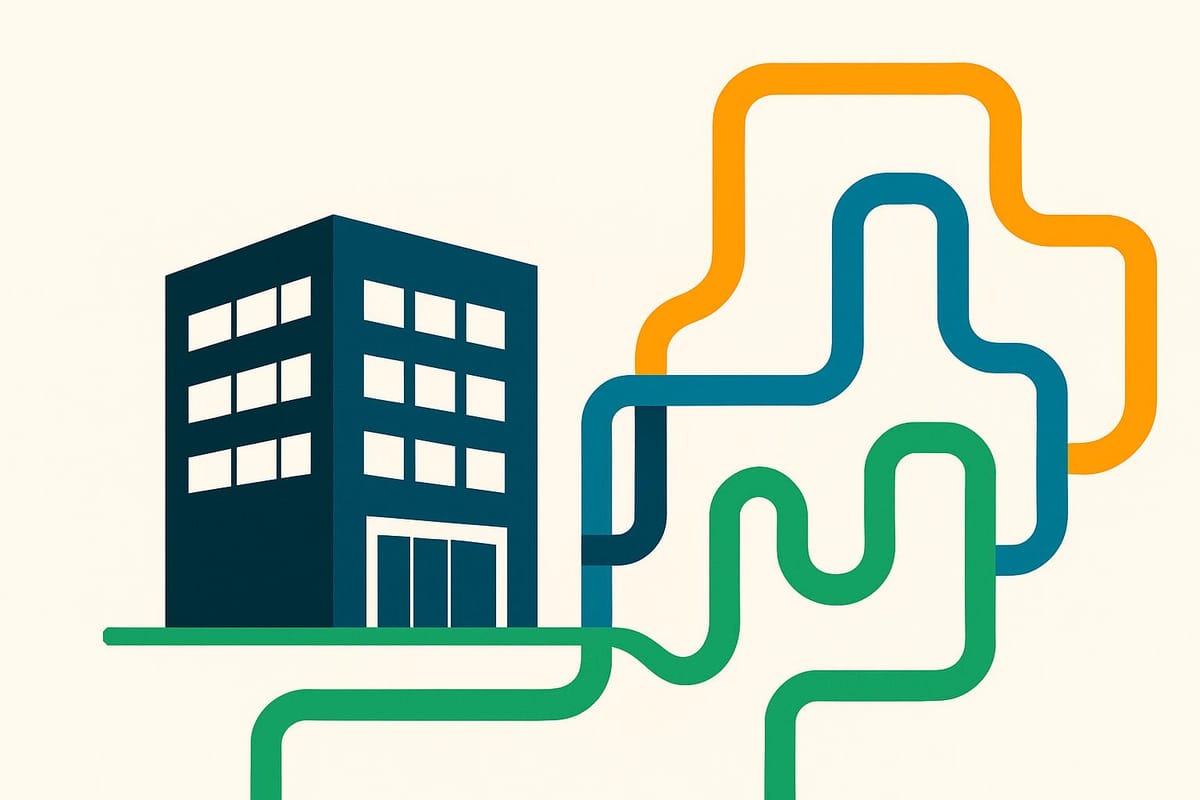
Scaling Agile in large enterprises is challenging but achievable with the right framework. When managing hundreds of teams, traditional Agile practices often fall short. This is where frameworks like SAFe, LeSS, Disciplined Agile, Scrum@Scale, and Nexus come into play. Each offers unique solutions to scaling Agile while addressing enterprise-specific needs like coordination, compliance, and cross-team dependencies. Here's a quick breakdown:
- SAFe (Scaled Agile Framework): Best for large enterprises needing structured coordination across hundreds of teams. Highly detailed but complex to implement.
- LeSS (Large-Scale Scrum): Simplifies scaling by sticking to core Scrum principles. Great for organizations willing to streamline management layers.
- Disciplined Agile (DA): A flexible toolkit to tailor Agile practices for diverse teams and projects. Suitable for enterprises with varied operations.
- Scrum@Scale: Lightweight and easy to implement, ideal for organizations already familiar with Scrum. Focuses on connecting teams in a network.
- Nexus: Builds directly on Scrum, designed for 3–9 teams working on a single product. Simple but limited scalability.
Quick Comparison
| Framework | Teams Supported | Complexity | Best For | Limitations |
|---|---|---|---|---|
| SAFe | 50+ teams | High | Enterprises with strict coordination needs | Overwhelming for smaller organizations |
| LeSS | 2–15 teams | High | Product-focused companies | Requires significant organizational changes |
| Disciplined Agile | Any size | Medium-High | Enterprises with diverse project portfolios | Requires skilled decision-making |
| Scrum@Scale | Flexible | Medium | Organizations with strong Scrum foundations | Relies on team self-organization |
| Nexus | 3–9 teams | Low | Mid-sized setups with integrated products | Limited scalability |
Choosing the right framework depends on your organization’s size, Agile maturity, and goals. Larger enterprises often prefer SAFe for its structure, while smaller setups might lean toward Nexus or Scrum@Scale. For those needing flexibility, Disciplined Agile offers customization options, and LeSS suits teams aiming to simplify coordination.
SAFe Vs. LeSS - Is It Really a Battle?
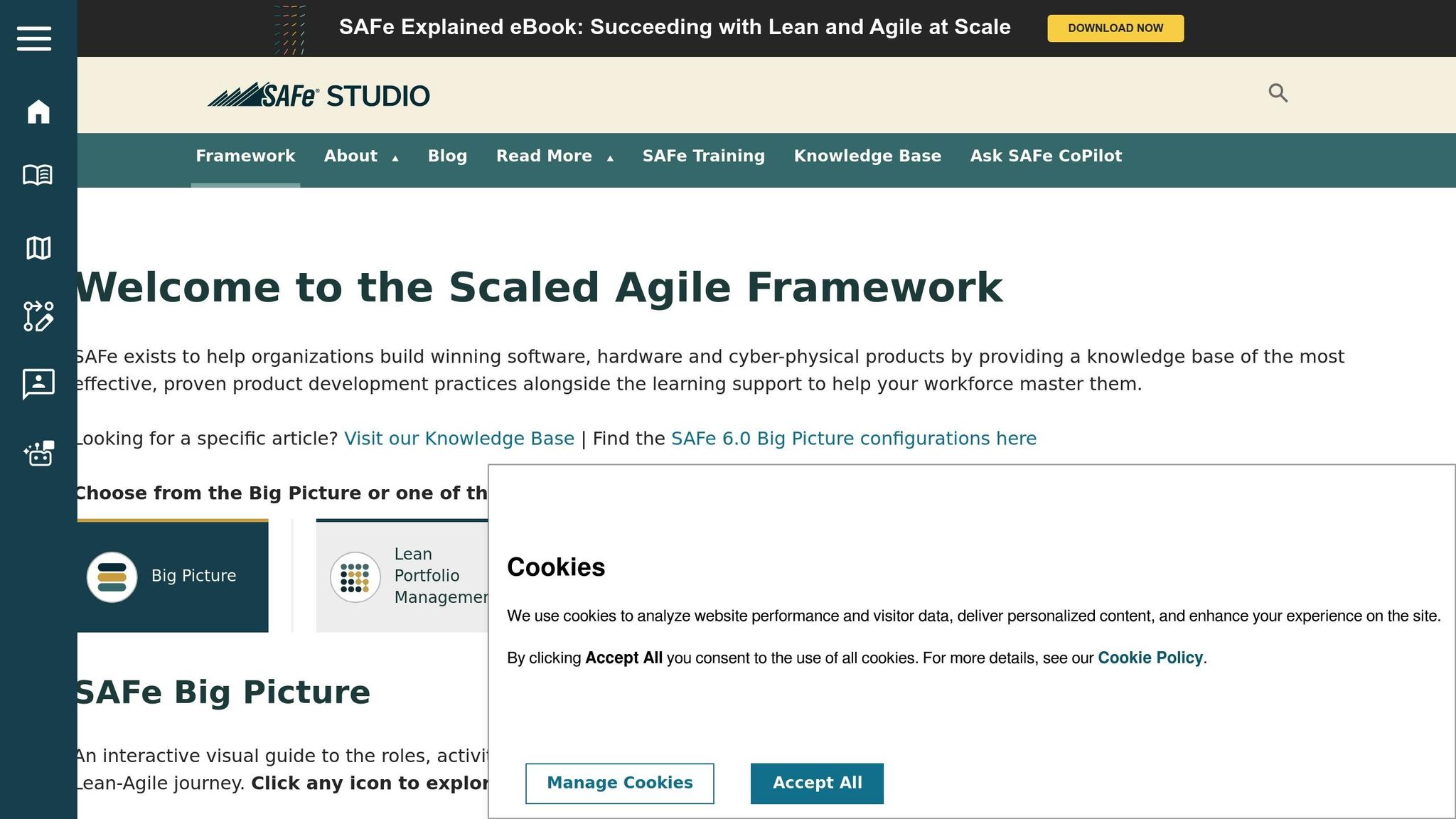
1. SAFe (Scaled Agile Framework)
SAFe is one of the most commonly used Agile frameworks for large organizations. Created by Dean Leffingwell and Scaled Agile Inc., it takes Agile principles from frameworks like Scrum and Kanban and scales them to fit the needs of enterprises with thousands of employees working on interconnected projects.
The framework is organized into four levels: Team, Program, Large Solution, and Portfolio. Each level has its own specific roles, ceremonies, and tools, creating a hierarchy that keeps everyone aligned - from top executives to individual development teams. This structured approach appeals to organizations accustomed to clear, traditional hierarchies.
Scalability
SAFe is particularly effective at managing large-scale organizational challenges. It supports hundreds of teams operating across different departments, time zones, and locations. A key feature is its Program Increment (PI) planning, which brings together up to 150 people to align on priorities and dependencies for the next 8-12 weeks.
Another cornerstone of SAFe is the Agile Release Train (ART), which consists of 50-125 people grouped into 5-12 Agile teams. These teams work collaboratively toward shared goals, while multiple ARTs are coordinated at the Large Solution level to tackle enterprise-wide initiatives involving thousands of employees.
What makes SAFe stand out is its governance structure. At the Portfolio level, leadership provides strategic direction and allocates budgets, while the Program level focuses on tactical execution. This separation ensures strategic oversight without micromanaging individual teams - a critical balance for large enterprises.
Implementation Complexity
While SAFe excels at scaling Agile, implementing it is no small feat. Its complexity can be both an asset and a hurdle. The framework includes over 100 roles, events, and tools spread across its four levels. For teams transitioning from traditional waterfall methods, this can feel overwhelming.
The certification process reflects this complexity. SAFe offers certifications like SAFe Agilist (SA) and SAFe Program Consultant (SPC), each requiring significant training. A full SAFe implementation typically takes 12-18 months, with a substantial upfront investment in training and coaching.
However, this complexity serves a purpose. SAFe provides detailed solutions for nearly every challenge large organizations face. Need to meet compliance standards? SAFe has you covered. Struggling with financial planning in an Agile setting? The framework includes portfolio-level financial practices. While the learning curve is steep, the guidance reduces uncertainty in implementation.
Flexibility
Despite its structured design, SAFe allows for some customization. The framework’s SAFe Implementation Roadmap encourages organizations to adapt its practices to their specific needs rather than applying them rigidly. Teams can refine their processes during PI planning, and quarterly reviews help the entire organization adjust and improve its SAFe adoption.
SAFe’s "inspect and adapt" approach promotes continuous improvement at all levels. However, its detailed structure can feel restrictive to organizations that value high autonomy. Teams accustomed to looser coordination might find the framework’s requirements limiting.
Organizational Fit
SAFe is ideal for organizations with 500 or more employees, multiple departments, and complex regulatory requirements. It's particularly effective in industries like finance, healthcare, and aerospace, where compliance and risk management are critical.
The framework also resonates with companies that have strong project management cultures. SAFe incorporates familiar elements like portfolio planning and program management offices, making it easier for traditional organizations to transition to Agile. This alignment is often crucial for securing buy-in from senior leadership.
That said, SAFe isn’t the best fit for smaller companies or startups that need minimal overhead and rapid decision-making. For businesses with fewer than 100 employees, simpler frameworks are often a better choice.
Up next, we’ll explore other frameworks that offer alternative ways to scale Agile in large organizations.
2. LeSS (Large-Scale Scrum)
For large enterprises aiming to simplify coordination, LeSS offers a streamlined approach to Agile scaling. Created by Craig Larman and Bas Vodde, LeSS focuses on reducing complexity by cutting down on extra roles, meetings, and artifacts. Its philosophy is all about achieving better outcomes with less overhead.
LeSS comes in two versions: one for smaller scaling efforts (2–8 teams) and another, called LeSS Huge, for larger setups involving 8 or more teams. Both versions stick closely to core Scrum principles, extending them across multiple teams working on a single product. This approach avoids adding extra layers of coordination, unlike some other frameworks.
Scalability
LeSS scales by removing traditional management layers rather than adding new ones. In a typical setup, all teams share a single Product Backlog, managed by one Product Owner. This setup ensures alignment without the need for complex coordination structures.
For organizations with up to 8 teams, standard LeSS works well. For larger implementations, LeSS Huge introduces Area Product Owners who oversee specific customer or technical areas while still reporting to a single overall Product Owner. Even in these larger setups, the structure remains relatively flat.
A standout feature of LeSS is its focus on organizational learning. Instead of prescribing rigid processes, it encourages teams to experiment and adapt, making it a good fit for organizations willing to embrace some initial uncertainty. However, this lean design requires significant organizational changes, which can be challenging to implement.
Implementation Complexity
LeSS isn’t just a framework - it’s a cultural shift. It moves organizations away from traditional top-down management toward a servant leadership model. While the framework itself appears straightforward, implementing it often requires rethinking established control and coordination practices.
This transition can be difficult, particularly for organizations accustomed to hierarchical structures. Many management roles are either redefined or eliminated, demanding strong executive commitment to drive the change. Unlike SAFe, which provides detailed step-by-step guidance, LeSS offers core principles and encourages teams to experiment, leaving much of the specifics up to the organization.
Training for LeSS focuses on deepening knowledge of Scrum fundamentals rather than teaching new scaling-specific practices. This means that teams need a solid understanding of Scrum before diving into LeSS, which could slow down implementation for organizations new to Agile.
Flexibility
LeSS gives teams a lot of freedom to organize their work. By imposing minimal constraints, it allows teams to self-organize around customer value rather than sticking to rigid structures. This adaptability helps teams adjust to evolving feature requirements and market changes.
The framework’s experimental mindset promotes ongoing adaptation, which works best for mature teams with strong leadership. However, organizations without experienced Agile teams may struggle with the autonomy LeSS demands. Its open-ended nature means that success relies heavily on the team’s ability to manage themselves effectively.
Organizational Fit
LeSS is particularly well-suited for product-focused companies with a strong technical foundation. It works especially well for software organizations developing a single product or platform, where technical excellence and direct customer feedback are priorities.
On the other hand, LeSS may not be the best choice for industries with strict regulatory or compliance requirements, such as financial services or healthcare. Its minimal governance structure doesn’t naturally provide the detailed audit trails or approval processes that these sectors often need. Similarly, organizations managing multiple, unrelated product lines might find its single-product focus limiting.
Startups and mid-sized companies, especially those with an entrepreneurial mindset, often find LeSS appealing for its balance of flexibility and coordination. However, large enterprises with rigid hierarchies may resist the flattening of organizational structures that LeSS requires.
3. Disciplined Agile (DA)
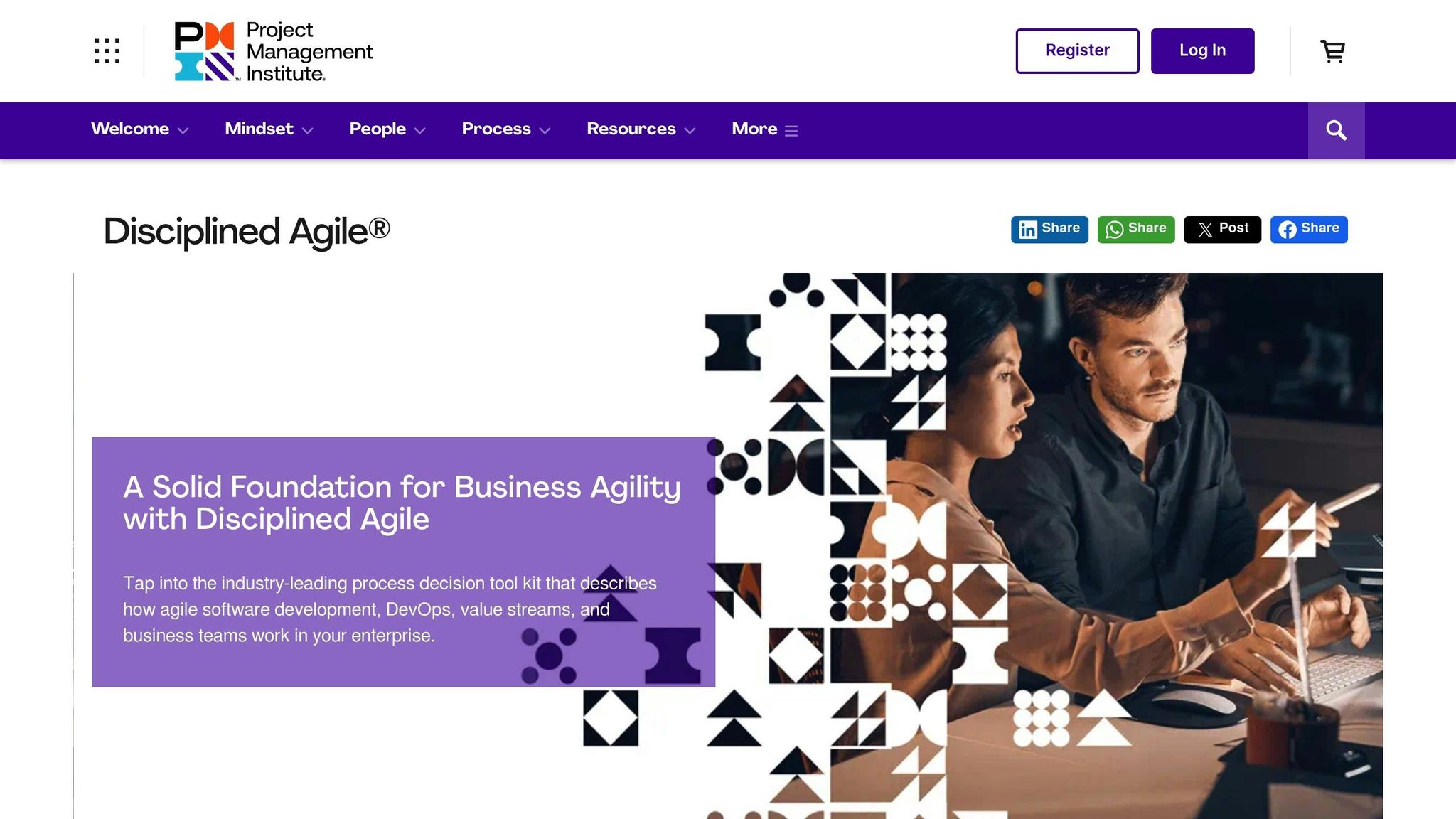
Disciplined Agile (DA) serves as a flexible toolkit designed for enterprise-level scaling. Created by Scott Ambler and Mark Lines, DA isn't a strict methodology but rather a set of tools and frameworks that help organizations choose practices tailored to their specific needs. Instead of offering a one-size-fits-all approach, DA provides decision-making frameworks that guide teams in selecting the best methods for their unique situations.
This framework is particularly well-suited for enterprises with diverse teams, projects, and operational cultures. DA supports teams by offering targeted guidance to navigate their options, avoiding rigid structures. This adaptability makes it a strong choice for large organizations with complex and varied operations. Unlike SAFe or LeSS, DA avoids imposing a fixed structure, providing a more customized approach for scaling Agile practices.
Scalability
DA approaches scaling with an emphasis on "enterprise awareness", focusing on integration rather than adding extra layers of structure. It acknowledges that teams are part of a larger ecosystem and must consider elements like enterprise architecture, data management, security, and governance from the outset. This perspective helps minimize common challenges associated with integrating Agile practices across an organization.
The framework supports scalability across multiple dimensions. Teams can expand by increasing their size, managing larger projects, addressing geographically distributed teams, or meeting regulatory compliance needs. DA stands out by seamlessly integrating operations, data, and strategy with development efforts, ensuring alignment across the enterprise.
DA is particularly effective for organizations managing mixed project portfolios. For example, a company might have teams building cutting-edge digital products while others maintain legacy systems or focus on regulatory compliance. DA provides tailored guidance for each scenario, avoiding the need for forced uniformity across fundamentally different types of work.
Implementation Complexity
The complexity of implementing DA depends on how extensively an organization adopts its practices. It offers a lightweight starting point that can be expanded as the organization matures. Teams can begin with basic Agile practices and incorporate more advanced techniques over time, aligning with their growing capabilities.
DA does come with a moderate and ongoing learning curve. Instead of requiring intensive upfront training, it promotes continuous learning and adaptation. Teams develop decision-making skills rather than memorizing predefined processes, which takes longer to master but delivers more sustainable results.
One challenge with DA is the need for skilled coaching. Since the framework emphasizes selecting the right practices rather than following a set path, teams often require guidance to make informed decisions. Organizations may need experienced Agile coaches who are familiar with multiple methodologies, not just DA itself, to fully benefit from the framework.
Flexibility
Flexibility is at the heart of DA. The framework recognizes that context matters more than consistency, allowing teams to tailor their practices to suit different projects while still operating within the same organizational framework.
DA enables teams to combine practices from various methodologies. For instance, a team might blend elements of Scrum, Kanban, or traditional project management, depending on what works best for their specific situation. DA provides clear guidance on how to integrate these methods effectively.
This choice-driven approach allows teams to adapt as circumstances evolve. A project might begin with one set of practices and transition to others as requirements, team dynamics, or external constraints shift. This adaptability makes DA especially valuable for long-term enterprise initiatives that must navigate changing conditions.
Organizational Fit
DA is best suited for large, complex organizations with diverse business units and a wide range of project types. It’s an excellent option for enterprises that have struggled with other frameworks, finding them too rigid or ill-suited to their organizational complexity. Companies in industries with strict compliance and governance requirements often appreciate DA's explicit focus on these challenges.
The framework aligns with organizations that prioritize pragmatism over rigid adherence to ideology. By focusing on outcomes rather than sticking to a single Agile approach, DA encourages teams to use whatever practices deliver the best results. This makes it appealing to enterprises balancing the need for innovation with operational stability.
However, DA may not be ideal for organizations seeking rapid, dramatic transformations. Its emphasis on thoughtful decision-making and gradual improvement is better suited for companies willing to invest in long-term development. Startups or organizations with simpler operations might find DA's comprehensive approach overly complex for their needs.
Organizations with strong change management capabilities tend to thrive with DA. Its success relies on skilled coaching and leadership committed to developing teams' decision-making abilities. With the right support, DA can help enterprises build lasting capabilities and adapt to evolving challenges effectively.
4. Scrum@Scale
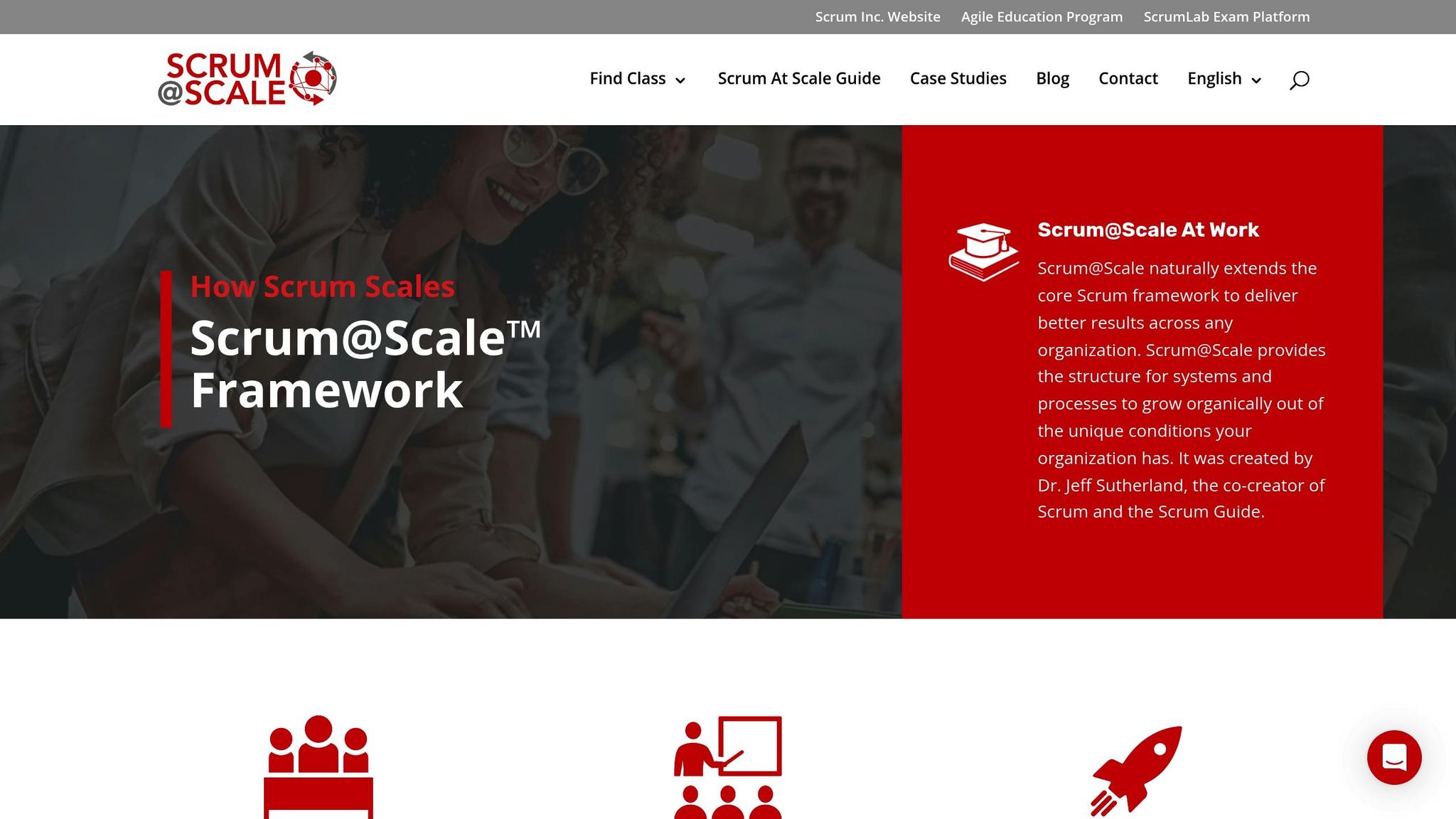
Scrum@Scale extends Agile principles to large organizations by using lightweight, networked coordination. Created by Jeff Sutherland, one of the original minds behind Scrum, this framework brings the simplicity of Scrum to enterprise-level operations. Instead of relying on complex hierarchies, it connects multiple Scrum teams through streamlined coordination. Let’s dive into its scalability, implementation, flexibility, and how it fits within organizations.
At its core, Scrum@Scale operates on the idea that scaling happens naturally when teams are well-connected and aligned. Rather than imposing rigid structures, it builds networks of teams that can adapt quickly to evolving business needs. This approach retains the agility that makes Scrum effective while addressing the challenges of coordination in larger setups.
One unique aspect of Scrum@Scale is its view of scaling as a fractal process - the same principles that guide individual teams can be applied at broader organizational levels. This creates a unified approach to coordination, ensuring consistency across the board.
Now, let’s explore how Scrum@Scale achieves scalability, ease of implementation, and adaptability.
Scalability
Scrum@Scale employs a Scale-Free Architecture, allowing organizations to grow without needing to overhaul their structures. This organic growth model ensures the framework can expand seamlessly as businesses evolve.
It achieves scalability through two key cycles: the Scrum Master Cycle and the Product Owner Cycle. The Scrum Master Cycle focuses on coordinating delivery across teams, ensuring smooth collaboration without overlap. Meanwhile, the Product Owner Cycle aligns all teams with shared business goals, keeping everyone on the same strategic path.
This framework also shines in coordinating distributed teams, whether they’re spread across time zones, locations, or even cultural contexts. It’s particularly effective for multinational companies and organizations with significant remote work operations.
Implementation Complexity
Implementing Scrum@Scale is often simpler compared to other enterprise frameworks because it builds on existing Scrum knowledge. Organizations already practicing Scrum can adopt it with minimal retraining or disruption to their workflows.
The framework’s minimal bureaucracy ensures teams stay connected without slowing down. Unlike other frameworks that introduce numerous roles and ceremonies, Scrum@Scale focuses on essential coordination points.
However, successful implementation requires strong foundational Scrum practices. Teams with inconsistent or weak Scrum habits may struggle, as the framework assumes a certain level of proficiency. For these organizations, building up their core Scrum capabilities is a necessary first step.
The learning curve for Scrum@Scale is generally manageable and targeted, making it accessible for teams already familiar with Agile methodologies. It provides clear guidance to address coordination challenges without overwhelming complexity.
Flexibility
One of the standout features of Scrum@Scale is its flexibility. While it offers clear principles, it allows organizations to tailor implementation details to suit their unique needs. This adaptability makes it suitable for industries with specific requirements, regulations, or preferences.
The framework’s network-based structure enables teams to be reconfigured, assembled, or disbanded as business needs change - without requiring major organizational shifts. This is especially valuable in industries where market conditions and product demands shift rapidly.
Scrum@Scale also supports mixed scaling approaches. Different parts of an organization can adopt the framework at varying intensities, allowing for gradual scaling or focusing efforts where they’re most needed. This reduces risk and provides room for learning and adjustments over time.
Additionally, it works with existing organizational structures, avoiding disruptions to reporting lines or departmental boundaries. This makes it easier for established businesses to adopt the framework without overhauling what already works.
Organizational Fit
Scrum@Scale is ideal for organizations that already excel at Scrum. It’s particularly well-suited for tech companies, digital product teams, or any business that needs to respond quickly to market changes.
The framework aligns with organizations that value speed and simplicity over rigid processes. Companies with strong engineering cultures or those that prioritize innovation often thrive with Scrum@Scale, thanks to its lightweight coordination approach.
For businesses managing complex product portfolios, Scrum@Scale offers a way to coordinate multiple products and initiatives without creating unnecessary dependencies. Teams can operate at their own pace while staying aligned with overall strategic goals.
Compared to more rigid frameworks like SAFe or LeSS, Scrum@Scale emphasizes decentralized decision-making and minimal overhead. This makes it a great choice for organizations with a solid Scrum foundation looking for a lightweight scaling solution.
That said, Scrum@Scale may not be the best fit for industries with heavy regulatory requirements. Its focus on speed and streamlined processes can clash with the need for extensive documentation and formal approvals in these environments.
On the other hand, companies experiencing rapid growth or frequent restructuring often benefit from Scrum@Scale’s adaptability. Its network-based design makes it well-suited for dynamic environments where traditional hierarchies might struggle to keep up.
5. Nexus
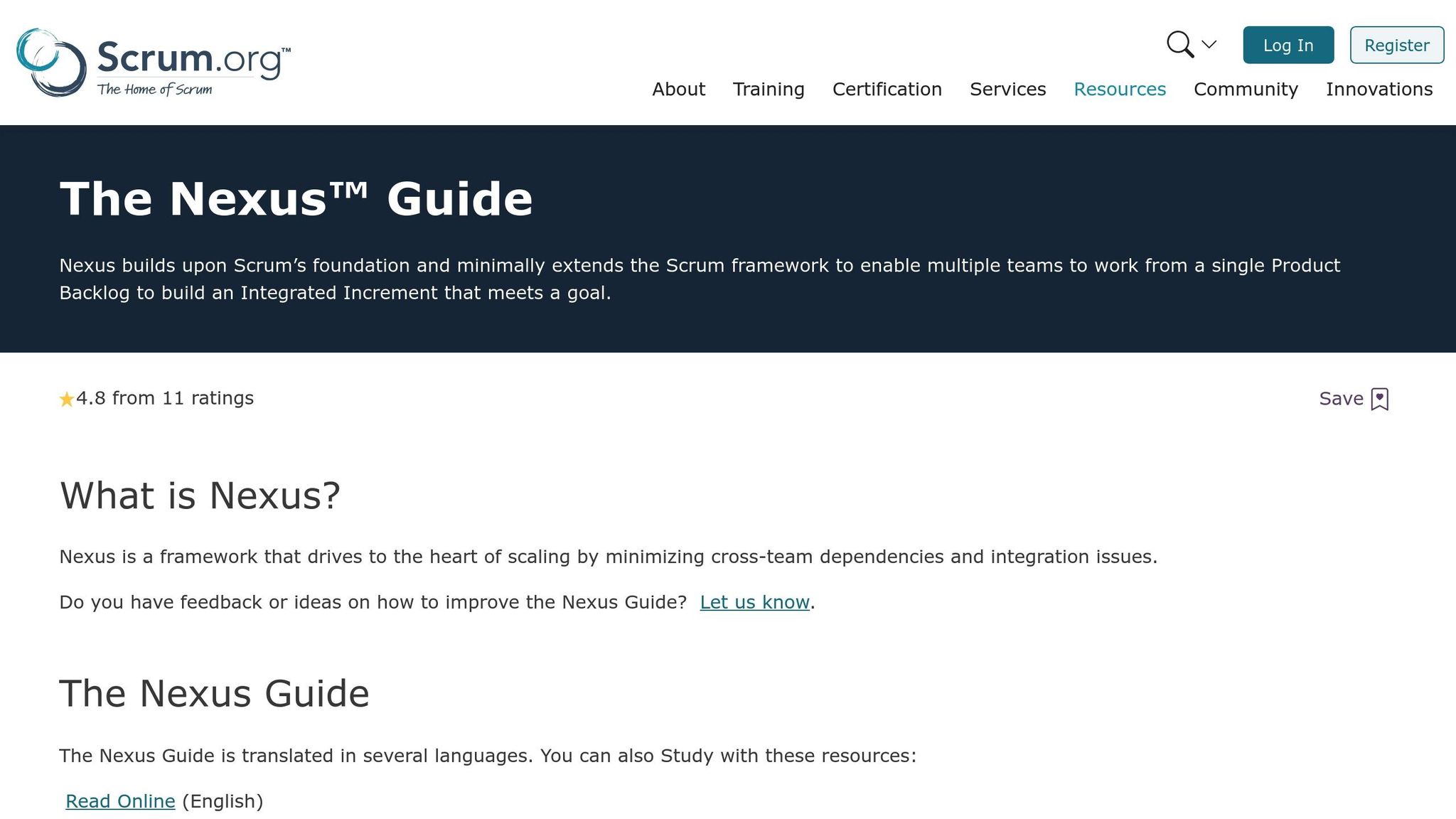
Nexus, created by Ken Schwaber of Scrum.org, is designed to scale Scrum for three to nine teams working together on a single product. It builds on familiar Scrum elements - events, artifacts, and roles - while introducing a Nexus Integration Team to manage complexity. The goal? To keep things simple and avoid adding unnecessary management layers, making it a great choice for organizations looking to scale Scrum without extra bureaucracy.
Scalability
Nexus works best with three to nine Scrum teams. This range is intentional - it avoids the chaos that can come with larger groups. All teams share a single Product Backlog and contribute to one Product Increment, ensuring alignment and reducing redundancy.
The Nexus Integration Team plays a key role here. It includes the Product Owner, a Scrum Master, and other team members who focus on integration and dependency management. Their job is to make sure the work from all teams comes together seamlessly, resulting in a product increment that’s ready to ship.
This approach is especially useful for organizations where multiple teams are responsible for different parts of the same product. It’s particularly effective when clear ownership of components is paired with the need for regular integration.
Implementation Complexity
For organizations already experienced with Scrum, Nexus builds on what they know, making it easier to adopt. However, the challenge lies in mastering integration practices. Teams need to establish a robust Definition of "Done" to ensure their work integrates smoothly with others.
If a team is still struggling with the basics of Scrum, scaling with Nexus could amplify those issues. Success depends on strong coordination and integration skills, which require clear communication, shared technical standards, and effective dependency management.
Flexibility
Nexus offers a balance between structure and adaptability. While it defines roles and events clearly, it allows teams to tailor practices based on their technical needs. For instance, teams can specialize - front-end, back-end, or otherwise - so long as they align on shared goals.
This framework also works well with different technical architectures, whether teams are dealing with microservices, monolithic applications, or hybrids. To maintain alignment, Nexus typically recommends synchronized Sprint boundaries for all teams, ensuring everyone stays on the same page.
Organizational Fit
Nexus is ideal for organizations where multiple teams collaborate on a single product, especially when strong integration practices like continuous integration and automated testing are already in place.
It’s particularly effective for mid-sized scaling needs - when a single Scrum team isn’t enough, but the organization isn’t yet large enough to require more extensive frameworks. Nexus provides just the right amount of structure to manage coordination without overcomplicating things.
This framework shines in technology-focused environments. Teams working on integrated platforms, mobile apps with multiple components, or web applications with complex front-end and back-end dependencies will benefit from Nexus's emphasis on technical coordination.
However, it’s not without limitations. Industries with strict regulatory requirements might find Nexus challenging, as its focus on working software over detailed documentation can clash with compliance needs. Additionally, companies experiencing rapid growth could outgrow Nexus’s capacity. With its focus on three to nine teams, organizations scaling beyond this range may need to consider more expansive frameworks down the line. For mid-sized challenges, though, Nexus provides a streamlined and effective solution.
Framework Comparison: Pros and Cons
Picking the right Agile framework for a large enterprise is all about balancing scalability, complexity, and how well it fits your organization. Each framework tackles the challenge of coordinating multiple teams in its own way, offering unique strengths and trade-offs. Here's a breakdown of how these frameworks stack up.
SAFe is the heavyweight champion for large enterprises. It’s designed to manage massive scale, coordinating hundreds of teams effectively. With over 1 million practitioners and 20,000 enterprises using it, the numbers speak for themselves. Many implementations boast a 20–50% boost in productivity and a 30–75% faster time to market. But that power comes with a hefty price tag - SAFe’s highly prescriptive structure and numerous roles demand significant organizational changes and a substantial investment in training and resources.
LeSS keeps things lighter by building on familiar Scrum principles while adding just enough structure to scale. It can handle thousands of practitioners with its LeSS Huge variant, making it a strong option for organizations aiming to grow without drowning in bureaucracy. However, it’s not a free pass - LeSS requires deep organizational changes and strong leadership, which some enterprises underestimate.
Disciplined Agile stands out as the most adaptable option. Instead of a rigid framework, it offers a toolkit that can scale to any size and adapt to diverse needs. This flexibility is ideal for mature Agile teams but can overwhelm those new to Agile. It requires skilled practitioners who can navigate its "choose-your-own-adventure" approach effectively.
Scrum@Scale takes a "Scrum of Scrums" approach, making it one of the easiest frameworks to learn. It enables flexible scaling with minimal complexity, allowing organizations to grow at their own pace. That said, it leans heavily on existing Scrum expertise and team self-organization, which can be a challenge for less experienced teams.
Nexus is the simplest option for organizations already proficient in Scrum. It builds directly on existing Scrum practices, requiring minimal adjustments and keeping complexity low. However, its scalability is limited - it’s best suited for smaller setups, as it maxes out at nine teams.
| Framework | Scalability | Implementation Complexity | Key Strengths | Major Limitations |
|---|---|---|---|---|
| SAFe | Very High | Very High | Structured coordination, proven results | Highly prescriptive; stifles creativity |
| LeSS | High | High | Lightweight, minimal additional process | Limited to 15 teams in basic form; systemic changes required |
| Disciplined Agile | Very High | Medium-High | Highly customizable, context-driven | Overwhelming for newcomers; steep learning curve |
| Scrum@Scale | Medium-High | Medium | Easy to learn, flexible scaling | Relies on strong Scrum proficiency |
| Nexus | Low–Medium | Low | Builds on existing Scrum knowledge | Limited scalability, not suitable for large enterprises |
The more scalable a framework is, the more complex its implementation tends to be. For example, SAFe’s ability to manage thousands of practitioners requires extensive training, new roles, and structured processes that can feel rigid. On the other hand, simpler frameworks like Nexus are easier to adopt but hit their limits quickly when scaling.
Ultimately, the right choice depends on your organization’s readiness and growth goals. Enterprises with a solid Agile foundation might thrive with LeSS or the flexibility of Disciplined Agile. Companies needing structure and proven processes often opt for SAFe, even if it’s more demanding. For those caught in the middle - not quite ready for SAFe but too large for Nexus - Scrum@Scale offers a nice balance of guidance and adaptability.
It’s worth noting that each framework has its critics. SAFe is often labeled "partially Agile" or even "anti-Agile" due to its reliance on traditional management practices. Meanwhile, lighter frameworks like LeSS and Nexus are praised for sticking to Agile principles but face criticism for their limited scalability. This underscores a key reality: achieving true enterprise agility often involves finding a compromise between Agile ideals and the practical needs of large-scale coordination.
Conclusion
Choosing the right Agile framework for your organization requires careful thought about your company’s size, culture, and current level of Agile expertise. Each framework has its own strengths, so aligning these with your specific needs is key.
- If your organization requires extensive coordination across multiple teams, SAFe might be the way to go.
- For teams already familiar with Scrum, LeSS or Scrum@Scale could be effective.
- If you need more adaptability, Disciplined Agile offers a flexible approach.
- For smaller-scale implementations, Nexus could be the best fit.
Before making a decision, take stock of your Agile maturity. Consider how many teams you’ll be working with, your existing Agile knowledge, and how much organizational change you’re ready to take on. Jumping into a framework that’s too complex - or one that’s too simple - can create more challenges than it solves.
Finally, remember that proper training is essential for success. Platforms like Upskillist offer Agile Project Management courses and an Enterprise Plan, which includes access to over 80 courses, unlimited learning opportunities, and SCORM compliance. This kind of training can help your teams confidently adopt Agile practices and ensure a smoother transition.
FAQs
What should large enterprises consider when selecting the right Agile framework?
When choosing an Agile framework, large enterprises need to consider a few key factors: project complexity, team size, and organizational objectives. For instance, frameworks like SAFe are specifically built to handle enterprise-level coordination, making them a great fit for large-scale, multi-team projects.
Another critical aspect is evaluating the organization's preparedness for change, familiarity with Agile methodologies, and capacity to handle cultural adjustments. Selecting a framework that complements your company’s structure and growth requirements can lead to a smoother rollout and better long-term results.
What steps can an organization take to successfully implement a complex framework like SAFe?
To implement SAFe effectively in a large organization, a structured approach is key. Begin by securing strong leadership support and fostering a shared sense of urgency across teams. This foundation helps create alignment and commitment to the transformation process.
Invest in thorough training at all levels to ensure everyone understands their roles and responsibilities within the SAFe framework. A well-informed team is better equipped to adapt to changes and contribute to the overall success of the initiative.
Setting up a lean-agile center of excellence and clearly outlining value streams and Agile Release Trains (ARTs) are essential steps. These elements help streamline team alignment and improve coordination across the organization. Address potential obstacles early, such as resistance to change, insufficient executive sponsorship, or gaps in training, to minimize disruptions and ensure a smoother transition.
By prioritizing collaboration and keeping a strong focus on achieving measurable outcomes, organizations can effectively manage the challenges of scaling Agile and set the stage for long-term success.
What challenges might a company new to Agile face when adopting Disciplined Agile (DA)?
Adopting Disciplined Agile (DA) can be a tough road for organizations that are new to Agile methodologies. One of the biggest obstacles is a lack of familiarity with Agile principles. When teams don’t have a clear grasp of the basics, confusion can arise, making it harder to implement DA effectively. Without proper training or guidance, teams may find it difficult to adjust to this framework.
Another significant challenge is resistance within the organization. Shifting to DA often means rethinking how things are done - both culturally and structurally. For larger companies, scaling Agile practices can be especially tricky. Managing collaboration across departments and addressing pushback from employees who are hesitant about change adds to the complexity. To navigate these issues, it’s crucial to secure leadership support and cultivate a mindset of ongoing improvement throughout the organization.

